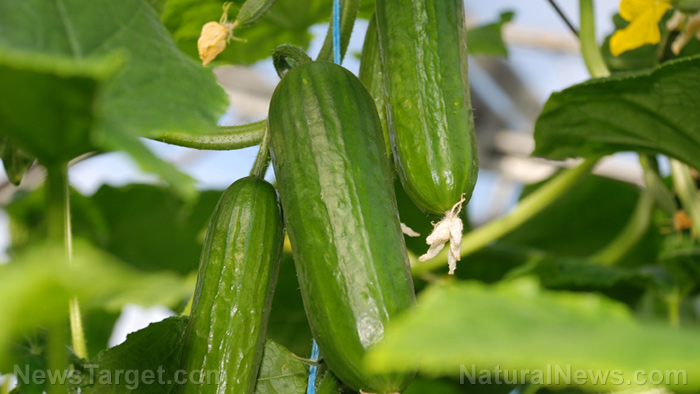
Advertisement
Cucumber and zucchini are two plants that are frequently confused with each other. After all, they’re both green, they’re both gourds and they’re both technically fruits, even though they’re treated as vegetables.
Nonetheless, cucumber and zucchini each have characters of their own and can be used to make pickles, cakes and dips. Here’s how these two superfoods differ from and resemble each other.
Nutritional values compared
Cucumber (Cucumis sativus) belongs to the Cucurbitaceae or the gourd family. It is cultivated in many parts of the world and is known for its cylindrical shape, dark green skin and pale flesh. It is often used as a vegetable.
Zucchini (Cucurbita pepo), on the other hand, is also a type of gourd but belongs to the same species as squash and pumpkin. In fact, zucchini is really a type of summer squash. It is usually harvested when it is still immature and its skin tender.
Both cucumber and zucchini contain over 90 percent water, which makes them very hydrating. Both foods also contain electrolytes, which help regulate and control the balance of fluids in your body. Plus, both foods are rich in fiber. This combination of water and fiber helps keep you regular and prevents constipation or bloating.
In terms of calorie content, cucumber and zucchini are both fairly light. A cup of unpeeled sliced cucumber has about 16 calories, while the same serving of unpeeled sliced zucchini contains around 19 calories.
In terms of nutrient content, both cucumber and zucchini offer many essential nutrients. One cup of cucumber offers less than five percent of the Recommended Dietary Allowance (RDA) for vitamin C, while the same serving of zucchini provides 24 to 27 percent of the RDA for vitamin C.
Vitamin C is an essential nutrient that helps protect healthy cells from inflammation and damage. Vitamin C is also involved in regulating blood pressure and keeping the arteries clear.
Cucumber and zucchini also contain vitamin B6. A cup of cucumber offers three percent of the RDA of vitamin B6, while a cup of zucchini offers twice that. Vitamin B6 helps your body make antibodies, which fight bacteria, viruses and other foreign invaders that could cause disease. It also supports healthy nerve function.
Both cucumber and zucchini contain other essential vitamins and minerals, such as manganese, vitamin K and folate.
Cucumber seeds are also a good source of calcium, while zucchini seeds contain powerful compounds that help protect cells from inflammation and damage. These compounds, which include flavonoids, lignans and triterpenes, are also present in cucumber, particularly in its peel.
How to tell cucumber and zucchini apart
Given their remarkably similar appearance, cucumber and zucchini are often mistaken for each other. But they are actually easy to tell apart if you know what characteristics to check. Here’s what you should look out for.
- Appearance – Cucumber and zucchini are both cylindrical and can be found in various shades of green. They’re easier to tell apart when cut open. Both foods have seedy flesh, but the cucumber’s flesh has a pale green tinge, while the zucchini’s flesh is a creamy white color. Cucumber seeds usually run down the middle of the gourd, while zucchini seeds are smaller and blend into the flesh.
- Texture – Cucumber is hard, waxy and cool to the touch, while zucchini is warmer and yielding. It has a slight grittiness under the fingertips as well. Cucumber also has a bumpy exterior, although some varieties, such as smaller Lebanese cucumbers, have smooth skin.
- Flavor – Cucumber has a mild, lightly sweet flavor. It is also crisp, cool and refreshing to eat raw. It may taste slightly earthy when eaten with the skin on. Zucchini, on the other hand, has a slightly sweet and slightly bitter flavor with a rich mouthfeel. Its sweetness becomes more apparent when it is cooked.
- Growth – Cucumber plants grow vines, and cucumbers themselves grow out of flowers anywhere along with the vines. Meanwhile, zucchinis grow from flowers at the base of the plant. Zucchini plants have woody stems as well.
How to use cucumber and zucchini
Cucumbers are almost always eaten raw and added to salads and sandwiches. Cucumbers are rarely cooked, as doing so can make them too soft. They can also be added to juices, infused into water or pickled.
In contrast, zucchini are almost always cooked. They’re commonly roasted or baked alongside other vegetables like eggplants and pumpkins. They can also be used in sweet treats, such as banana bread or carrot cake.
Zucchinis are sometimes added raw to salads or julienned to make a low-carb alternative for spaghetti noodles. In the latter case, the zucchini can also be flash-boiled.
No matter which gourd you prefer, both cucumber and zucchini make healthy additions to a balanced diet. Try incorporating them into your go-to recipes today.
Sources:
Advertisements







